| dc.contributor.advisor | Xanthos, Theodoros | |
| dc.contributor.author | Ψαρρά, Βασιλική | |
| dc.date.accessioned | 2024-10-07T08:51:55Z | |
| dc.date.available | 2024-10-07T08:51:55Z | |
| dc.date.issued | 2024-10-01 | |
| dc.identifier.uri | https://polynoe.lib.uniwa.gr/xmlui/handle/11400/7578 | |
| dc.identifier.uri | http://dx.doi.org/10.26265/polynoe-7410 | |
| dc.description.abstract | Εισαγωγή: Ο σίδηρος αποτελεί θεμελιώδες στοιχείο για τη ζωή και τυχόν διαταραχές του επηρεάζουν τη φυσιολογική λειτουργία του ανθρώπινου οργανισμού. Ενδεικτική της σημαντικότητας της ομοιόστασης του σιδήρου είναι η κλινική εικόνα των βαρέως πασχόντων ασθενών, οι οποίοι χαρακτηρίζονται από σιδηροπενική αναιμία ή αναιμία της φλεγμονής. Η έγκαιρη παρακολούθηση των δεικτών ομοιόστασης του σιδήρου σε συνδυασμό με τους δείκτες φλεγμονής και την ταυτοποίηση μικροβίων σε αιμοκαλλιέργεια μπορούν να οδηγήσουν σε ασφαλή συμπεράσματα για την εξέλιξη της νόσου.
Σκοπός: Στην παρούσα Διπλωματική Εργασία αναλύθηκαν την Ημέρα Εισόδου (επί θετικής αιμοκαλλιέργειας) και την Ημέρα Εξόδου, οι Δείκτες Φλεγμονής Σίδηρος (Fe), Φερριτίνη (Ferr), Προκαλσιτονίνη (PCT), C - Αντιδρώσα Πρωτεΐνη Υψηλής Ευαισθησίας (CRP hs) και Λευκά Αιμοσφαίρια Αίματος (WBC). Επίσης συγκεντρώθηκαν δημογραφικά στοιχεία ασθενών όπως η Ηλικία και το Φύλο. Τέλος καταγράφηκαν το είδος Μικροβίου, η Θερμοκρασία Σώματος (Θ.Σ.), η Νόσος και η τελική Έκβαση νόσου. Διερευνήθηκαν η τροποποίηση των υπό μελέτη παραμέτρων σε συνάρτηση με τον χρόνο νοσηλείας των ασθενών καθώς και η συσχέτισή τους με την επιβίωση των ασθενών.
Μέθοδος: Χρησιμοποιήθηκαν δείγματα ορού και ολικού αίματος από εκατό βαρέως πάσχοντες ασθενείς που νοσηλεύτηκαν στη Μονάδα Εντατικής Θεραπείας ή σε κοινές κλίνες νοσηλείας του Νοσοκομείου Metropolitan General. Η επεξεργασία και ανάλυση των δειγμάτων έλαβε χώρα στα Κεντρικά Εργαστήρια Metropolitan General.
Συμπεράσματα: Όλοι οι δείκτες φλεγμονής που αναλύθηκαν παρουσίασαν μεταβλητότητα μεταξύ των Ημερών Εισόδου και Εξόδου. Αναφορικά με την έκβαση της νόσου, ο Fe και η PCT αποδείχτηκαν σημαντικοί προγνωστικοί δείκτες, όπως προέκυψε από τα ποσοστά θνησιμότητας. Ιδίως ο ρόλος της PCT στους βαρέως πάσχοντες ασθενείς, που αποτελούν μια κατηγορία ασθενών πρόκληση της Σύγχρονης Ιατρικής, είναι αδιαμφισβήτητα καταλυτικός.
Λέξεις κλειδιά: Σίδηρος, Δείκτες Φλεγμονής, Προκαλσιτονίνη, Βαρέως Πάσχοντες Ασθενείς, Μικρόβιο | el |
| dc.format.extent | 53 | el |
| dc.language.iso | el | el |
| dc.publisher | Πανεπιστήμιο Δυτικής Αττικής | el |
| dc.rights | Αναφορά Δημιουργού - Μη Εμπορική Χρήση - Παρόμοια Διανομή 4.0 Διεθνές | * |
| dc.rights | Attribution-NonCommercial-NoDerivatives 4.0 Διεθνές | * |
| dc.rights.uri | http://creativecommons.org/licenses/by-nc-nd/4.0/ | * |
| dc.subject | Σίδηρος | el |
| dc.subject | Δείκτες φλεγμονής | el |
| dc.subject | Προκαλσιτονίνη | el |
| dc.subject | Βαρέως πάσχοντες ασθενείς | el |
| dc.subject | Μικρόβιο | el |
| dc.subject | Iron | el |
| dc.subject | Inflammatory markers | el |
| dc.subject | Procalcitonin | el |
| dc.subject | Critically ill patients | el |
| dc.subject | Microbe | el |
| dc.title | Αξιολόγηση δεικτών ομοιόστασης σιδήρου σε βαρέως πάσχοντες ασθενείς με μέτρηση δεικτών φλεγμονής και ταυτοποίηση μικροβίων: Ο ρόλος της προκαλσιτονίνης ως διαγνωστικό εργαλείο | el |
| dc.title.alternative | Evaluation of iron homeostasis markers in critically ill patients by measurement of inflammatory markers and microbial identification: The role of procalcitonin as a diagnostic tool | el |
| dc.type | Μεταπτυχιακή διπλωματική εργασία | el |
| dc.contributor.committee | KARKALOUSOS, PETROS | |
| dc.contributor.faculty | Σχολή Επιστημών Υγείας & Πρόνοιας | el |
| dc.contributor.department | Τμήμα Βιοϊατρικών Επιστημών | el |
| dc.contributor.master | Βιοϊατρικές Μέθοδοι και Τεχνολογία στη Διάγνωση | el |
| dc.description.abstracttranslated | Introduction: Iron is a fundamental element for life and any disorder affects the normal functioning of the human body. Indicative of the importance of iron homeostasis is the clinical picture of critically ill patients, who are characterized by iron deficiency anemia or anemia of inflammation. Early monitoring of iron homeostasis markers in combination with inflammatory markers and identification of microbes in blood culture can lead to safe conclusions about the progression of the disease.
Purpose: In this Diploma Thesis, the Inflammatory Markers Iron (Fe), Ferritin (Ferr), Procalcitonin (PCT), C-Reactive High Sensitivity Protein (CRP hs) and White Blood Cells (WBC) were analyzed on the Admission Day (on positive blood culture) and on the Day of Discharge. Patient demographics such as Age and Gender were also collected. Finally, the type of Microbe, the Body Temperature (BT), the Disease and the final Outcome of the disease were recorded. The modification of the parameters under study in relation to the hospitalization time of patients as well as their correlation with patient survival were investigated.
Method: Serum and whole blood samples were used from one hundred critically ill patients hospitalized in the Intensive Care Unit or in common hospital beds of the Metropolitan General Hospital. The processing and analysis of the samples took place at the Central Laboratories of Metropolitan General.
Conclusions: All markers of inflammation analyzed showed variability between the Admission Day and the Day of Discharge. Regarding the outcome of the disease, Fe and PCT proved to be important predictors of mortality rates. In particular, the role of PCT in critically ill patients, which is a challenging category of patients in Modern Medicine, is undoubtedly catalytic.
Key words: Iron, Inflammatory Markers, Procalcitonin, Critically Ill Patients, Microbe | el |


